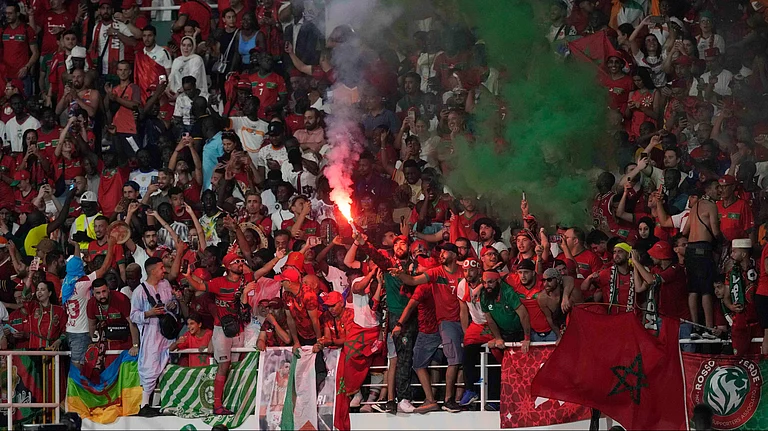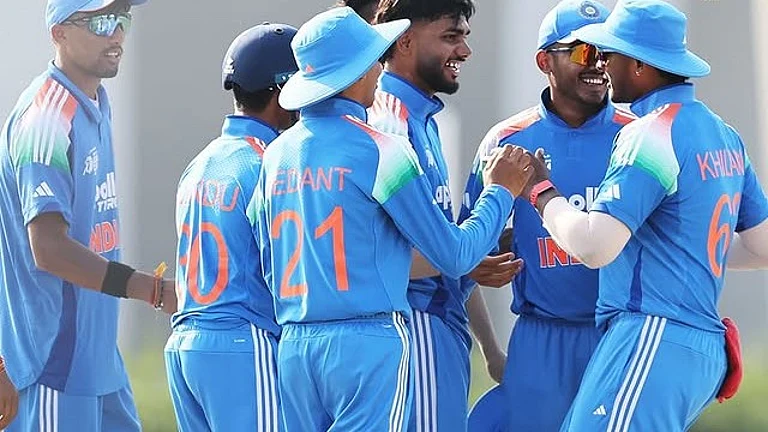The year is 2023, and we’re elaborating on the concepts of freedom and independence. The one sponsored by the State defines it as a moment of arriving. The period—kaal—yug—of the Amrit—nectar kind. This is defined in all government advertisements and celebrations. This practice is not unique to the present government. Every twenty-five years, the citizens of the republic are called to stand up for their nation. The logos of the patriotic celebration changes; the rest remains pretty much sacred. Any intervention to that settled narrative is costing people and earning them the label of villainous actor of treachery and harm.
As a nation, we started off bankrupt and empty-handed. Such is the story we needed to tell. And we told it promptly. Then came the blame game. The obvious target was the White British man. Whiteness was the first identity that the colonial regime injected into the diverse castes of many nations. This inadvertently provided a form of cultural unity to the dangerous cleavages of the pre-colonial divided society. The colonial administration governed with relative ease in India. Thanks to the hierarchies of societies divided by caste, religion and language. The only difficulties the White man and his woman and children had were the equatorial heat, endemics, diseases and spicy food (not the one they came here hunting for).
The common enemy ideal is set in popular culture, academic textbooks, national lore and the nation’s objectives. Once set, it is propagandised among the citizens that they commit to the nation. In doing this, the citizens make a pact with the past. This, in turn, keeps haunting the new republic that doesn’t offer a refuge to the models of the future and commitments to modernity. Citizens are enamoured with the past because it offers them a venue to vent their frustration. They remain there and cuss out their contemporary life by blaming the past. The State finds this narrative appealing because it is unable to offer any justifications for the newfound independence of the country.
When the hungry masses demand food and shelter, and the State is unable to provide it, then nationalistic zeal is alternated between hunger and national symbols—flags, cows, religion, culture, and so. The subaltern mass still adhere to the State narrative by giving it a chance. The second time, it is not heavily invested in the relics of the historic clichés as it was in the first time. Over time, and a couple of generations later, the mass demands accountability from the State.
To avert this attention, the State comes down heavier. It now calls its own citizens terrorists of the society. They are accused of declaring an act of disgruntled mass treason. The mass is foisted upon with the might of the law that favours the ruling class. With the power of the legislature, the executive is called to serve the taxpayers with force and violence. The third time, the mass choose alternative methods to seek justice. They organise and hit the streets to show their power.
The government operates like a bully in disguise, unable to attend to the necessities of the masses and their desires. They fail to develop new strategies to divert attention. Media is resorted to in order to create fake narratives and give the masses emotional fodder than jobs.
The State calls its own citizen-lords Naxals or vandals. The frustration of the poor and the downtrodden is seen through a clear prism. The oppression in society and by the State machinery demand scrutiny. Each state has its own dirty secrets that are hidden. The deep-state phenomenon works through a chain of conspiracies. But the script of squeezing the last drop of sweat of the people for their labour and creating a surplus to bail out the rich continues. The outcastes suspect the State as they continue to be bullied, raped and murdered. The State is called to action. Pressure is mounted on the State as well as the social actors in cahoots with the power players.
A Panther is born to find justice on its own. It is very powerful, and it knows, but it is also someone who prefers to wait for the right time.
The Dalit Panthers of India started off by challenging the State and its society which was poorly trained to deal with the horrors of caste. Problems of communities derive from the organised power structures of the State. Thus, the new literary young guns blazed their pens to chart the stories of oppression and suffering. It was not unlike like the past. The last time India had seen or read something like that was in 1936. These writers and poets drew inspiration from the same man who had spent many years on the fight for justice—Dr Ambedkar.
The Dalit Panthers spoke from the stage, recited poetry in the middle of the streets, or wrote down their militant thoughts. This sent shudders through the State and society. The Panthers were uncontainable. They were not on the wrong side of history either. They were not also advocating a turn-down of the State. What they were demanding was a share in the State and justice at once. They could not be wronged, yet, they were Ambedkarites who chronicled a struggle by creating new solidarities centred on the vulnerable and precious lives of Dalits.
The first organisational set-up began in 1972. Thereafter, several Dalit Panthers emerged across India in various states. Keeping the regional dimensions in context, the Dalit Panthers protested nationally. Units were formed in over 17 states.
***
It was the golden jubilee of the formation of the Dalit Panthers. I thought of documenting it and preserving the watershed moment for future archives. It is also an occasion to reflect from the distance of a time map while staying at the core of the struggles. Many Panthers have died, but many are alive. The stories of those gone and those alive resonate in the rage and passion of Dalits. There have been many versions of the Panther story. The biographers of the movements have written it according to their recollection and understanding. There are versions of Raja Dhale, Namdeo Dhasal, J.V Pawar and Arjun Dangle, and many more books and articles written in Marathi and other regional languages. Four books published this year alone provide the historical trajectory of the Panther biography. Vitthal Shinde, Shridhar Pawar, Sunil Awachar and Rajendra Gonarkar wrote or edited books on the topic. Among the founders, we have different readings of the beginning of the movement because it was prematurely discarded, leaving limited reflection on the movement. But the common Panther story is filled with militancy, action and poetry.

The first golden jubilee commemorative event happened in Nanded. It was also the first time the Dalit Panthers and the Black Panthers were on the same stage. One of the founders of the Dalit Panthers, J.V. Pawar, witnessed and met the Black Panthers for the first time. He was emotional and announced from the stage that he would take the Black Panther Party T-shirt that he was gifted to his grave. Senior witnesses of the movement and leaders gathered in Nanded and many other places. The story of the Dalit Panthers is not merely celebratory. It is also reflective.
The Black Panther Party, in their official newspaper, offered their support and appreciation to the Dalit Panthers in Vol. 11, no 20-22 of the 11 May, 1974 edition. They reported the launch of the manifesto that explained who the Dalits are and the atrocities committed against them by the ‘non-untouchables’. The newspaper reproduced an article in the LA Times written by A.S. Abraham, a journalist with the Times of India, that chronicled the history of the Dalit Panthers, explaining to the American audience about this new phenomenon that was partly inspired by the Black Panthers of America.

I had planned a similar cross-cultural solidarity event for the Dalit and Black Panther communities to join together in a conference in the US. Veteran leaders would meet each other at the conference. J.V. Pawar had wanted me to get Bobby Seale to come to the event. So, I reached out to him. His agent replied, ‘‘Bobby is very interested.” They asked for a budget. I replied accordingly, explaining the event was organised by working-class people who might not be able to afford the hefty fees. The agent had spoken too early. Bobby was unable to take an international trip but was happy to offer a virtual speech at a certain fee that was beyond our entire budget. Still, the Dalit Panthers tried. This shows that neither of the Panthers could raise resources for themselves as organisations. They could not institutionalise their vision. As a result, they struggled to bring their objectives to fruition. Many seniors remain like the ageing oaks providing support and radical empowerment. The Panthers lived by the commitment to the ideology and did not part with their principles. In a capitalist society, principles are sinful. Those who stick by morals come out as victors. This is a double-edged sword because the Dalit Panthers, like other radical movements in India, were assimilated into the electoral party politics of the ruling castes.
The Congress Party started interfering in the affairs of Dalit reform. Following them, other political parties staked a claim to the grassroots-based, organic Dalit leaders. Many charismatic Dalit leaders who were non-compromising in their youthful days adjusted to the party structures, following the orders of their party bosses who were much younger than them and who belonged to the very classes they had started their fight against.
When the idea of a special number for the Dalit Panthers came to my mind, an apt space to explore this project was found in Outlook. The magazine has been a welcoming platform for newer ideas and Dalit-centric projects for some time. I had done the ‘50 Dalits’ edition with them two years ago for a special number on Ambedkar Jayanti. Thus, while travelling in the Balkans, I reached out to the managing editor, Satish Padmanabhan, with this idea. He liked it. After several discussions, the project was finally sealed with Chinki Sinha, the editor, offering a new dimension to this special issue by making it inclusive of other Dalit stories, not just the Panthers. That is certainly the aim of this historic issue. We wanted to look at the story of the Panthers critically but also at other movements of Dalits that continue to wage war against injustice and atrocities. I was particular about documenting the past and the contemporaneity of that past. A search to cover the dusty pages of history took fourteen months across the country to meet writers, leaders, activists and ministers who were Panthers.
This issue is a souvenir for the Dalit movement’s history with research articles, interviews, reportage, poetry, artwork and photography. Though a few more articles were commissioned including one on Raja Dhale, Namdeo Dhasal and Bombay history, and Yuvak Kranti Dal, the authors couldn’t deliver in time.
The idea of the Panthers resonated across India. The Liberation Panthers Party of Tamil Nadu, the VCK, are in parliament and the Assembly now. I hitched a ride for two days with the leader Thol. Thirumavalan, who will cross sixty in a week, to get clarity on his movement’s objectives. Initially, it began as a Dalit movement with a Tamil nationalist slant. Its five-fold objectives with a broader global anti-imperial, gender-sensitive programme of the annihilation of caste. The leadership and the party cadres have found refuge in Ambedkarite values along with Marx’s classless society and Periyar’s rationalism.
Now, they are looking forward to the Buddhist past merging into the broader India story that warrants their safety and security. Pandit Iyothee Thass acts as a connection to Tamilian Buddhist history.
***
The Dalit Panthers became famous in 1972 after the publication of an article called ‘Black Independence Day’ by Raja Dhale in Sadhana, a Socialist weekly in Marathi. The article was published for a special issue on Dalits that Sadhana printed under the editorship of Anil Avchat. In it, Dhale had called out the supposed independence of India.
He pointed out the incident of Brahmangaon in Parbhani district wherein Dalit women were paraded naked. He compared the incident with the Indian flag, whose disrespect invited harsher punishments than the harm done to the life and honour of a Dalit woman. He then openly referred to the Indian flag as a rag. Dhale was drawing attention to the aesthetics of nationalism as opposed to the horrors that citizens undergo. “Nation is made by the people. In it, are the pains of the people bigger or harm caused to a symbol?...The one who believes in caste is a donkey,” he declared.
Dhale sharpened his literary tool by social prognosis. His references to the emotional rhetoric of empty nationalism can be viewed as timeless. The recent public attack on two Manipuri women of the Kuki tribe by a mob incurred the disgust of the country. Dhale had reminded us on the twenty-fifth anniversary of India’s independence about the hollowness of this day. The incident in Manipur is an assurance of the protest led by the Dalit Panthers that was necessary and calls for its revival now.
Suraj Yengde is a scholar at harvard and Oxford Universities


























